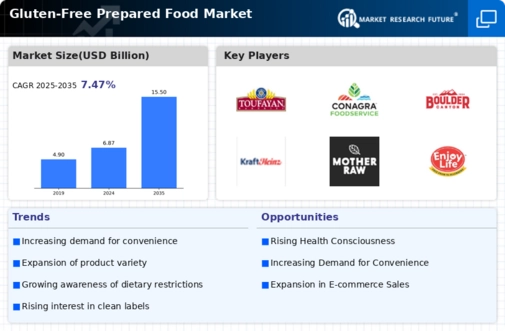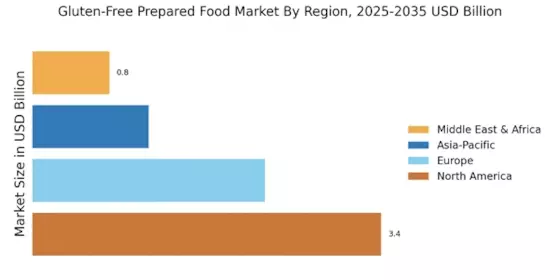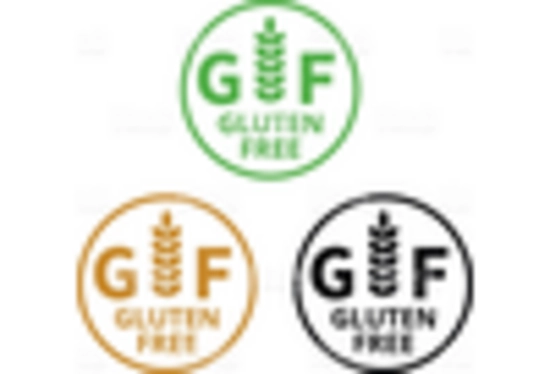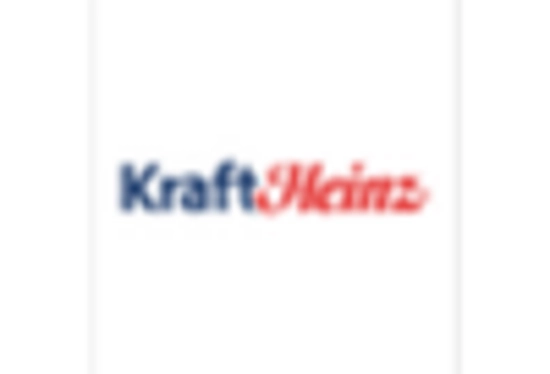Growing Trend of Healthy Eating
The shift towards healthier eating habits is a prominent driver of the Gluten-Free Prepared Food Market. Consumers are increasingly prioritizing nutrition and wellness, leading to a surge in demand for gluten-free options perceived as healthier. Research indicates that a significant portion of the population is actively seeking foods that align with their health goals, including weight management and improved digestion. The gluten-free diet is often associated with these health benefits, which may explain the rising interest in gluten-free prepared foods. As more consumers adopt health-centric lifestyles, the Gluten-Free Prepared Food Market is likely to expand, with manufacturers responding by innovating and diversifying their product lines to meet evolving consumer preferences.
Rising Prevalence of Gluten Sensitivity
The increasing awareness and diagnosis of gluten sensitivity and celiac disease appear to be driving the Gluten-Free Prepared Food Market. As more individuals recognize the health implications associated with gluten consumption, the demand for gluten-free options has surged. Recent estimates suggest that approximately 1 in 100 individuals worldwide are affected by celiac disease, leading to a heightened need for gluten-free prepared foods. This growing consumer base is not only seeking gluten-free products for health reasons but also for lifestyle choices, thereby expanding the market. The Gluten-Free Prepared Food Market is likely to see continued growth as awareness campaigns and educational initiatives promote gluten-free diets, further influencing consumer purchasing behavior.
Influence of Social Media and Food Trends
The role of social media in shaping food trends cannot be underestimated, particularly in the context of the Gluten-Free Prepared Food Market. Platforms such as Instagram and TikTok have popularized gluten-free diets, showcasing recipes and products that appeal to a wide audience. This visibility has led to increased consumer interest and experimentation with gluten-free options, driving sales in the prepared food sector. Influencers and health advocates often promote gluten-free lifestyles, further legitimizing the market. As social media continues to influence consumer behavior, the Gluten-Free Prepared Food Market is expected to benefit from heightened awareness and engagement, potentially leading to increased market penetration and growth.
Regulatory Support for Gluten-Free Labeling
Regulatory frameworks supporting gluten-free labeling are emerging as a crucial driver for the Gluten-Free Prepared Food Market. Governments and health organizations are establishing guidelines that define gluten-free standards, thereby enhancing consumer trust in gluten-free products. For instance, regulations stipulating that products must contain less than 20 parts per million of gluten to be labeled as gluten-free are becoming more common. This regulatory clarity not only protects consumers but also encourages manufacturers to innovate and expand their gluten-free product lines. As compliance with these standards becomes more widespread, the Gluten-Free Prepared Food Market is likely to experience growth, as consumers feel more confident in their purchasing decisions.
Increased Availability of Gluten-Free Products
The expansion of retail channels and online platforms has significantly enhanced the availability of gluten-free products, thereby impacting the Gluten-Free Prepared Food Market. Supermarkets, specialty stores, and e-commerce platforms are increasingly stocking gluten-free prepared foods, making them more accessible to consumers. Data indicates that the gluten-free food segment has experienced a compound annual growth rate of over 10% in recent years, reflecting the rising consumer demand. This increased availability not only caters to those with dietary restrictions but also attracts health-conscious consumers looking for gluten-free alternatives. As retailers continue to expand their gluten-free offerings, the Gluten-Free Prepared Food Market is poised for further growth, driven by consumer convenience and choice.


















Leave a Comment